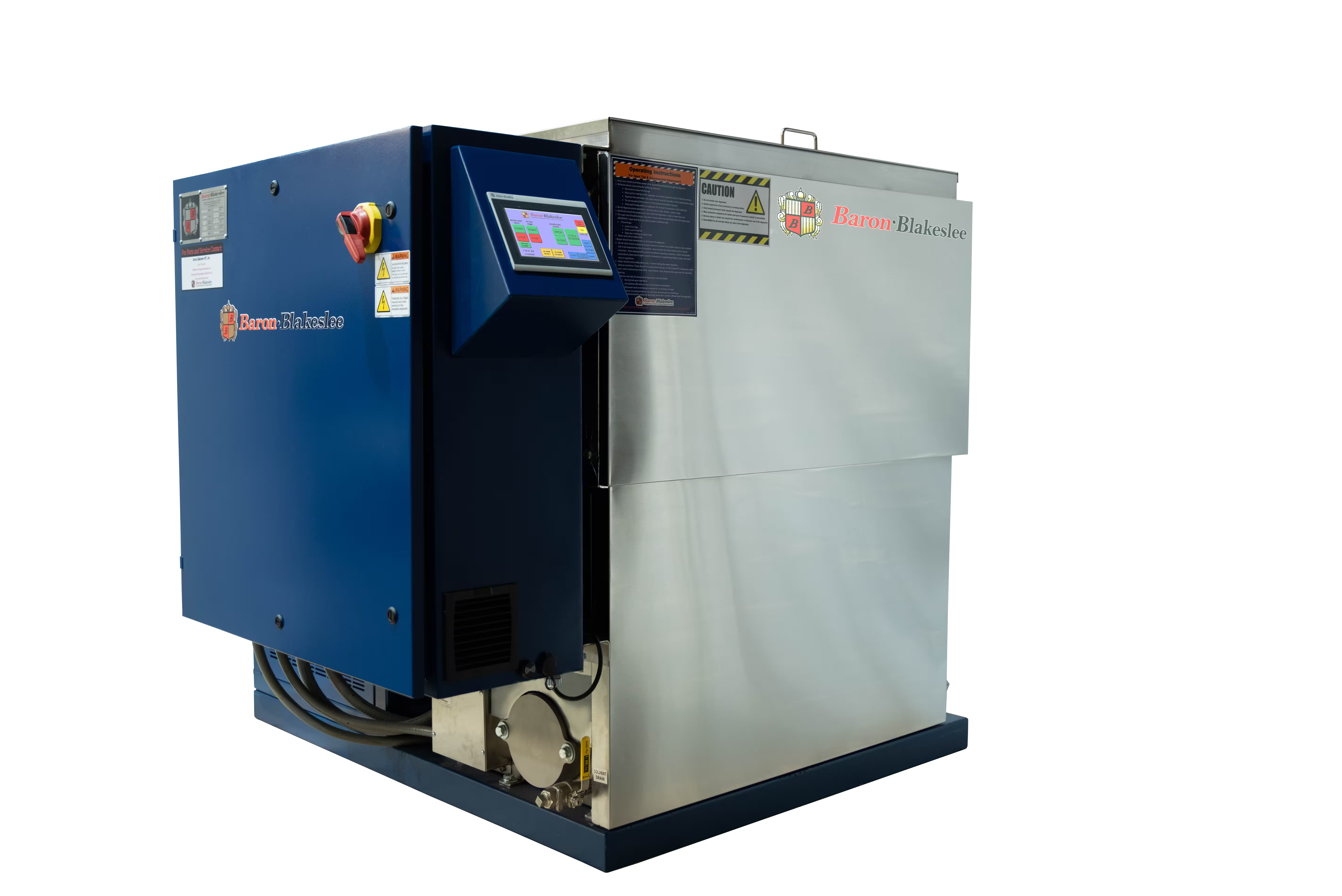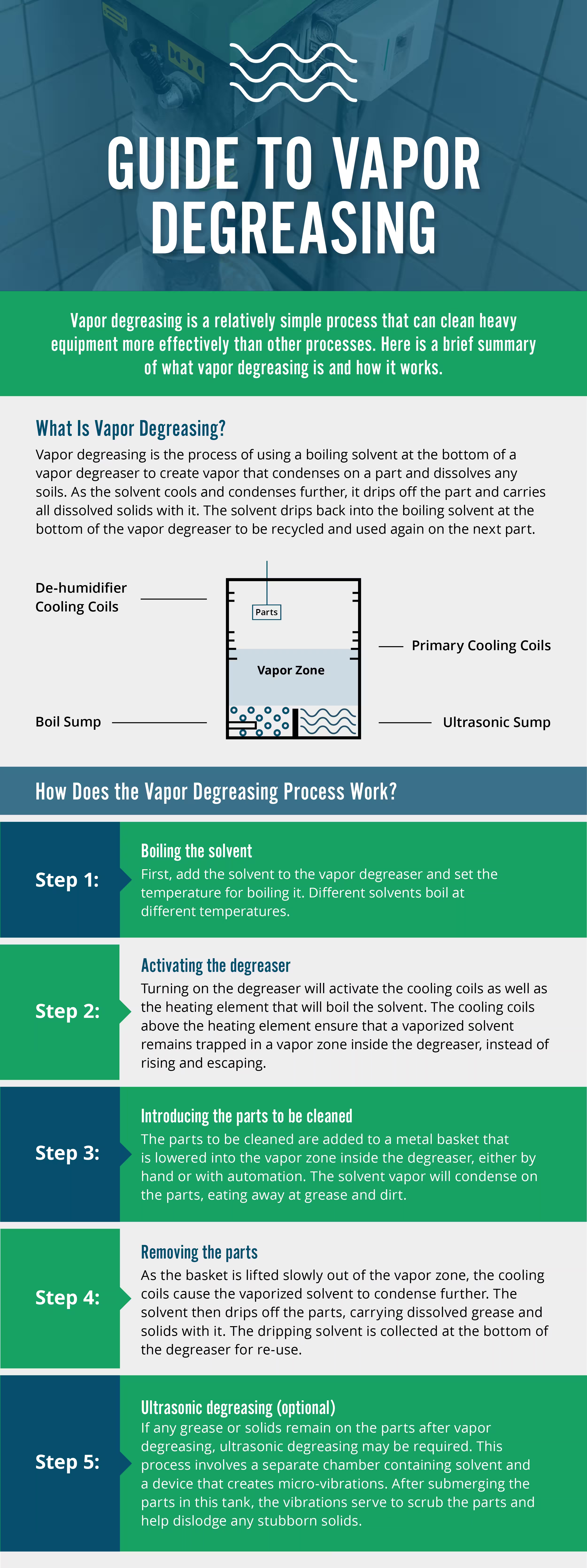The vapor degreasing process is a simple and streamlined, yet highly effective and economical, means of degreasing and cleaning parts of all shapes and sizes. A single compact machine performs all the steps necessary for precision cleaning — including rinsing, scrubbing and drying — with minimal effort from the machine operator and without the use of water. Instead of water, it’s the solvent that does the heavy lifting here.

The vapor degreasing process works by boiling a solvent to create a vapor, which then condenses on the surface of each part. Once on the surface, the solvent dissolves any soils on the part. The liquid solvent and soils are lifted from and then drip off the part via gravity, to be recycled back into the boiling solvent for additional cleaning.
Other cleaning processes require multiple machines for rinsing, scrubbing and drying. The need for multiple machines means a higher upfront cost, higher incurred energy costs, longer cleaning time and more floor space needed to accommodate such machinery.
Vapor degreasing is a solvent cleaning process. Simply put, a vapor degreaser is a metal apparatus with heating elements at the bottom and cooling coils toward the top. Once solvent is in the machine and the machine is turned on, the heating element brings the liquid solvent to a boil, turning the solvent gaseous. The cooling coils located above the heating element prevent the solvent vapor from escaping the device, creating an atmosphere.
After the parts are lowered into the atmosphere, the vapor clings to and condenses onto the parts. Then the parts are lifted out of the atmosphere, and the liquid solvent drips off the parts via gravity and back into the reservoir for recycled use. When the procedure is finished, the parts are dry and clean of all soils.
The first step of the solvent cleaning process is to pour the solvent into the vapor degreaser. Next, set the temperature that you want the solvent to reach. This temperature varies depending on the solvent you choose; different solvents have different boiling temperatures. The end goal is to get the solvent to a boil, which causes it to turn gaseous.
After the proper temperature is set, turn the vapor degreaser on to initiate both the cooling coils and the heating element. Once the vapor degreaser reaches the proper temperature and the solvent is boiling, you are ready to start cleaning your parts.
These last steps can either be automated or done manually. Place the items that need cleaning in a metal basket and slowly lower the basket into the gaseous atmosphere, which is below the cooling coils but above the boiling solvent. Allow the solvent vapor to cling to and condense on the parts. As you slowly lift the basket out of the vapor degreaser, the solvent drips off the parts and falls back into the boiling solvent, leaving the parts clean and dry.
Chemical solvent cleaners such as n-Propyl Bromide (nPB) and fluorinated solvents are used instead of water in the vapor degreasing process. Some of the more recent fluorinated additions to the marketplace, including NEXT 3000 and EnSolv® NEXT solvents are more environmentally responsible alternatives to earlier degreasing solvents.
As with most industrial processes, vapor degreasing is not dangerous so long as proper safety protocols are followed. One of the most important considerations in this regard is ventilation. It is recommended that a floor draft system be installed.
In addition, you should always use personal protection equipment, and consult the safety data sheet included with your solvent shipment for specific handling and usage instructions.
Ultrasonic degreasing is an optional further step in vapor degreasing. It is used if oil and flux remain on parts after the basket is lifted out of the vapor degreaser’s gaseous atmosphere.
A separate reservoir in the vapor degreaser contains a solvent as well as a device that creates micro vibrations in the liquid solvent. When the basket with parts is fully submerged in this tank, the ultrasonic vibrations work in a similar fashion to scrubbing, helping to remove contaminants from the parts.
After holding the parts in the ultrasonic tank for some time, simply lift the basket into the atmosphere and then slowly lift out just as you would if you had not used the ultrasonic degreasing tank. Check out the attached vapor degreasing guide for more information.
Once you have all the facts, get in touch with us to learn more about our complete product line. We’re ready to answer any questions and help you find the solution that’s right for you.

